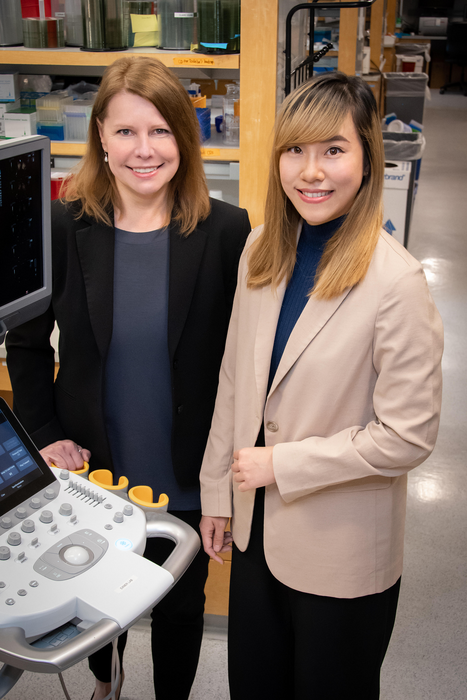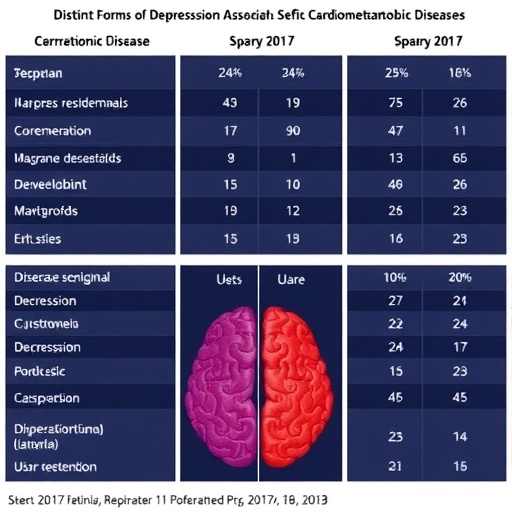CLEVELAND—Beyond vaccines, mRNA offers immense potential to fight disease, but targeting the genetic material to specific diseased cells is challenging—requiring a new method.

Credit: Case Western Reserve University
CLEVELAND—Beyond vaccines, mRNA offers immense potential to fight disease, but targeting the genetic material to specific diseased cells is challenging—requiring a new method.
To meet this need, researchers at the Case Western Reserve University School of Medicine, with a Global Research Fellowship award from Moderna Inc., are developing a process that essentially uses bubbles to overcome the problem.
“If these challenges can be overcome, this approach could lead to new and more effective ways of delivering therapies to specific cells in the body,” said Agata Exner, the Henry Willson Payne Professor and vice chair for basic research in the Department of Radiology at the School of Medicine, who is leading the research. “This could be especially important in treating diseases like cancer or genetic disorders, where specific cells need to be targeted without harming healthy cells.”
Moderna, a leading COVID-19 vaccine producer, recently awarded postdoctoral scholar Pinunta “Petch” Nittayacharn in the Exner lab the fellowship for their work in the drugmaker’s inaugural round of research grants.
Messenger ribonucleic acid—mRNA for short—is a genetic material that tells the body how to make protein. Vaccines, like Moderna’s COVID-19 vaccine, use mRNA that, when injected, triggers an immune response inside the body. The immune response produces antibodies that protect people from illness.
To take mRNA’s disease-fighting effectiveness even further, Exner and Nittayacharn are working to develop a more efficient way to deliver the material into targeted cells using tiny gas-core particles—called nanobubbles (NBs)—with a targeting molecule to deliver the mRNA into specific cells.
When combined with noninvasive, gentle sound waves that can be used without harming the body, the NBs can make it easier to enter cells by “cavitation,” or popping the bubbles, resulting in more efficient gene delivery, Nittayacharn said.
The approach has been tried with larger microbubbles, but the particles were too big to escape the blood vessel and move into the surrounding tissue, the researchers said. But NBs are 1,000 times smaller and can escape from leaky blood vessels in diseases—such as tumors—and accumulate in the targeted tissue.
“Of course, there are still many challenges and potential limitations to this approach that will need to be addressed, such as optimizing the design of the NBs, ensuring that the mRNA is effectively released from the NBs once inside the cell and minimizing any potential toxicity or immune reactions,” Exner said. “The future of mRNA delivery will be shaped by this, and many other approaches being developed in research labs worldwide.”
###
About Case Western Reserve University
Case Western Reserve University is one of the country’s leading private research institutions. Located in Cleveland, we offer a unique combination of forward-thinking educational opportunities in an inspiring cultural setting. Our leading-edge faculty engage in teaching and research in a collaborative, hands-on environment. Our nationally recognized programs include arts and sciences, dental medicine, engineering, law, management, medicine, nursing and social work. About 5,800 undergraduate and 6,300 graduate students comprise our student body. Visit case.edu to see how Case Western Reserve thinks beyond the possible.
About Moderna
In over 10 years since its inception, Moderna has transformed from a research-stage company advancing programs in the field of messenger RNA (mRNA), to an enterprise with a diverse clinical portfolio of vaccines and therapeutics across seven modalities, a broad intellectual property portfolio, and integrated manufacturing facilities that allow for rapid clinical and commercial production at scale. Moderna maintains alliances with a broad range of domestic and overseas government and commercial collaborators, which has allowed for the pursuit of both groundbreaking science and rapid scaling of manufacturing. Most recently, Moderna’s capabilities have come together to allow the authorized use and approval of one of the earliest and most effective vaccines against the COVID-19 pandemic.
Moderna’s mRNA platform builds on continuous advances in basic and applied mRNA science, delivery technology and manufacturing, and has allowed the development of therapeutics and vaccines for infectious diseases, immuno-oncology, rare diseases, cardiovascular diseases and auto-immune diseases. Moderna has been named a top biopharmaceutical employer by Science for the past eight years. To learn more, visit www.modernatx.com.




